Main Content
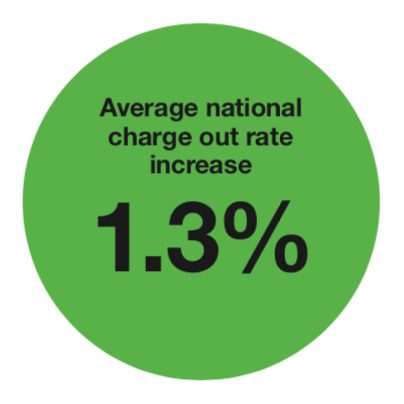
Topical findings from the DBA Annual Survey Report, and how to apply them to your business
The 2022 DBA Annual Survey Report is hot off the press and packed full with valuable benchmarking data. From maintaining a healthy operating profit, to managing pay rise requests, targeting new sectors, reducing invoice payment delays and more, DBA Experts share advice you can apply to your business.
Operating profit
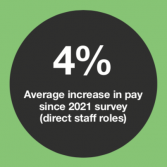
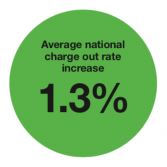 The 2022 DBA Annual Survey Report found that while charge out rates have only increased by an average of 1.3%, associated staff are seeing pay rises averaging 4%.
The 2022 DBA Annual Survey Report found that while charge out rates have only increased by an average of 1.3%, associated staff are seeing pay rises averaging 4%.
“A design business, that wants to make a reasonable operating profit (15%+) needs to ensure that costs of salaries + overheads are no more that 85% of Gross Income,” says Gary Baxter. “Typically the 85% is split between salaries at 55%-58% and overheads of 27%-30%. If salary costs rise, without income rising accordingly, it will not be possible to achieve the target operating profit % without making cuts in other operating costs.”

The ratio of salaries to charge out rates is an important metric for any agency to consider.
“Design businesses that see themselves as ’selling their time’ rather than delivering a valuable investment, will be challenged by the pressure coming from rising salary costs,” says Gary. “Ideally charge-rates should be an INTERNAL device used to keep projects on track and in this context they should be increased to reflect rising costs. Depending on where a consultancy is in it’s growth cycle, it may be appropriate to have several ‘rate cards’ to fit the size and sophistication of the client.”
Targeting new sectors
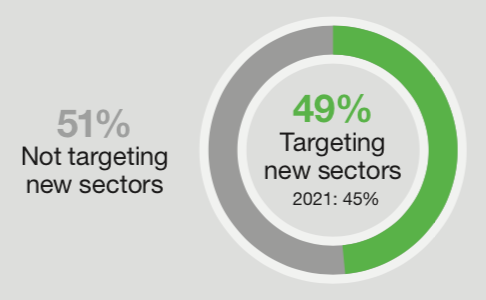 Nets are being cast wider in terms of finding potential clients, with 49% of agencies targeting new sectors.
Nets are being cast wider in terms of finding potential clients, with 49% of agencies targeting new sectors.
“Targeting new sectors is a natural part of agency growth, whether it’s deciding to be niche, or wanting to diversify work or revenue,” says Adam Graham. “You should always remain grounded by your North Star and not pursue a sector just because others do. Consider your values, the growth potential, creativity opportunities, and the sector knowledge of your people. Some sectors do better in recessions, but be mindful and empathetic around the struggles all businesses are going through.”

To maximise your success, Adam suggests:
- Look to your case studies of where you can draw comparable challenges and insights that could be transferred from other sectors.
- Don’t try to be a specialist or pretend to know more than the client, but do your research to make sure you understand the market and consumers.
- If you lack case studies, then use insights and thought leadership to showcase your opinion and act bold.
Fixed pricing
There’s been a 5% decrease in the proportion of agencies offering fixed prices; down from 66% in 2021 to 61% in 2022.
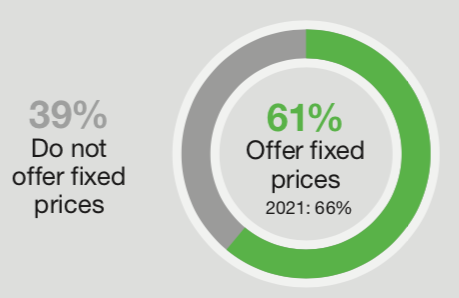 “Fixed pricing can still be your friend as much as your enemy in times of economic turmoil,” says Jeremy Paterson, “the key is to remember your lifelong accumulation of skills and experience has validity and value based on their impact and effectiveness, as much as the time it takes to deliver. Bearing this in mind be confident and ensure that the price to work ratio is equitable for the work being done, and not just an attempt to drive your fees down.”
“Fixed pricing can still be your friend as much as your enemy in times of economic turmoil,” says Jeremy Paterson, “the key is to remember your lifelong accumulation of skills and experience has validity and value based on their impact and effectiveness, as much as the time it takes to deliver. Bearing this in mind be confident and ensure that the price to work ratio is equitable for the work being done, and not just an attempt to drive your fees down.”

Jeremy offers these tips:
Be Steadfast – hourly rates are calculable, comparable and open to rigorous negotiation based on empirical truths. Fixed and value based pricing structures are harder to deconstruct. Defend your pricing.
Time Bound – present proposals in a time bound manner by including an expiry date not too far in the future and with a committed delivery timeline with implications for non-adherence. This creates a sense of urgency around approval and protects from the gnawing effects of inflation.
Clarity – a client genuinely endorsing a fixed price approach will confidently know and share their budget because the essence of the methodology is that the business case has been tested in advance.
Confidence – stand your ground, be confident on your agency value and of the reasons you are best placed to meet the client’s challenge.
Internal realism – when you define a fixed or value based quote – work your internal planning, costing and resourcing as rigorously as you would a project based on time and always bear in mind there is a difference between a fixed price or value based project and time based project that the client says is too expensive.
Empathy – understand how the client will define project value and build your proposal and costing around that understanding.
Pay rises

While the majority of agencies are planning pay rises, what about those businesses that can’t?
“The war on talent is still fierce with inflated salaries still carrying heavy weight to influence people’s moves,” says Aliya Vigor-Robertson. “For businesses where it has not been possible to increase salaries I have seen agencies review internal practices to impact efficiencies that support effective collaboration, flexibility and strong internal communication. I have also seen businesses look to review their benefits packages to ensure they are meaningful for their teams.”
And when it comes to managing expectations around pay rises, Aliya advises that “it is important to communicate and update your team each quarter on company targets and figures. Having some transparency on the numbers helps manage expectations and every request must be handled fairly and consistently.”
Freelancer use
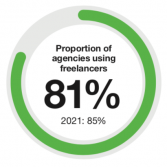 Although there’s been a 4% drop in the number of agencies using freelancers, the proportion of agencies spending over 12% of wages on freelancers has grown from 27.6% to 43%, highlighting the importance of freelance resource.
Although there’s been a 4% drop in the number of agencies using freelancers, the proportion of agencies spending over 12% of wages on freelancers has grown from 27.6% to 43%, highlighting the importance of freelance resource.
“As well as getting the cost balance right, there are a few questions to ask when looking at the permanent/freelance staff mix,” says Adrian Day. “Those questions include:

- Are any of my key client relationships held by freelancers? What are the risks associated with that?
- Are any of the key deliverables of our proposition only deliverable by freelancers? What are the risks/rewards of that strategy?
- What is the permanent/freelance resource balance for any one key client – for example is any one large client only serviced by freelancers? Is that a concern?”
Payments
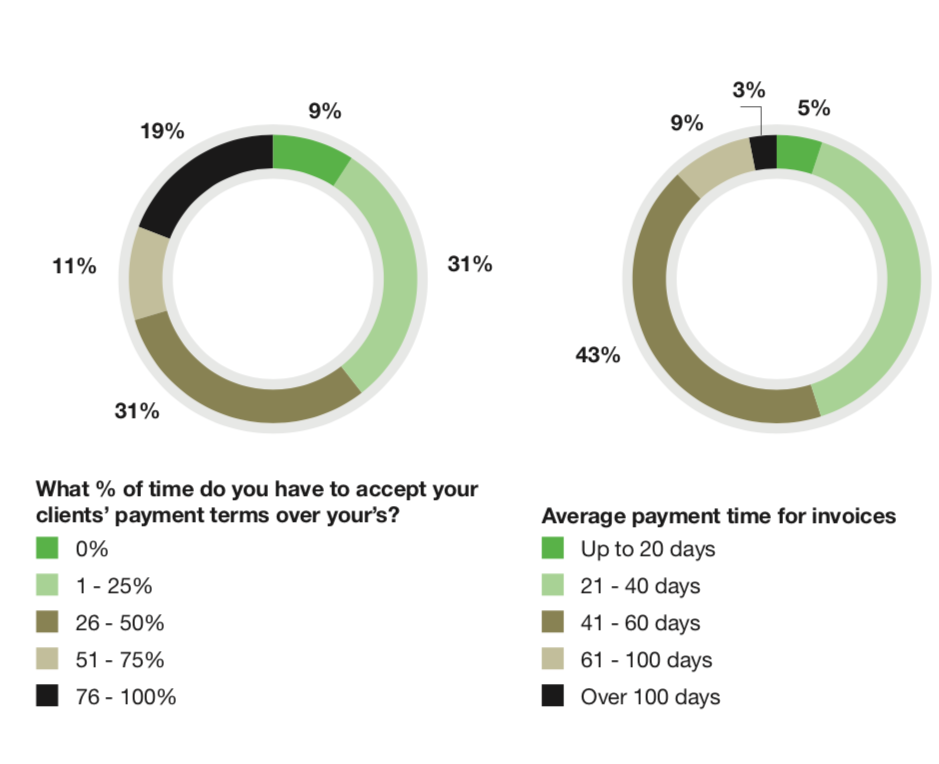 The design industry standard is to offer 28-day payment terms, but more often than not, 30% of respondents to the DBA Annual Survey had to accept their clients’ longer payment terms. Over 50% of invoices are taking 41 or more days to be paid.
The design industry standard is to offer 28-day payment terms, but more often than not, 30% of respondents to the DBA Annual Survey had to accept their clients’ longer payment terms. Over 50% of invoices are taking 41 or more days to be paid.
“Remember that, even in the largest and most ‘corporate’ of your clients, you have a contact of your own who has influence within their business. Their procurement or finance department might well be laying down their default payment terms, but at the end of the day those departments are support functions for the business and telling every amazing but small creative business that they’re going to have to suck up 90-day payment terms is going to leave them with few agencies who can afford to work with them,” says Peter Carter. “Lean on your contact either to reduce those terms or to enable you to do a chunky invoice up-front, so at least the clock can start ticking early on the first payment.”

To reduce payment days, Peter suggests:
- Have your finance team or book-keeper check in politely with your client a week before your invoices are due for payment, to make sure they’ve received and processed the invoice, and to check “out of courtesy” whether they have everything they need in order to effect payment on time.
- Make sure you invoice immediately as soon as you can legitimately do so, especially on project work with milestones and completion dates. There’s no point leaving a possible invoice three weeks after you could have sent it, and then wondering why you don’t have any cash.
- In the case of retainers, if you don’t already, considered invoicing them in advance at the beginning of the month or quarter too.

The DBA Annual Survey Report is an invaluable members-only business tool which enables you to benchmark your financial performance with your peers. Released each October it covers fees, salaries, utilisation, income, recovery rates, benefits and trends within DBA member companies. Data is segmented by geography and size of agency to make comparisons more relevant. Find out how members use the Report and how to access a copy.
DBA members can also login and watch a recording of the 2022 DBA Annual Survey Report launch webinar, featuring Esther Carder, Partner at Moore Kingston Smith presenting a detailed analysis of the benchmarking data and trends.
DBA Experts
DBA Experts are here to help you navigate the challenges and decisions you face as you grow your business. Our register of accredited expert consultants have sustained and relevant experience in supporting the design industry, so you can rest assured that you will be getting sound, high-level support.
Our Experts have extensive experience supporting the creative industries and are:
- DBA approved.
- Recommended by peers.
- Reference checked.